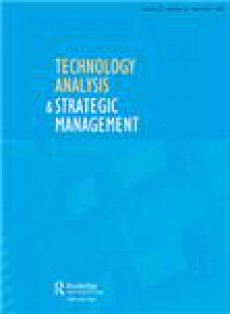技术分析与战略管理
技术分析与战略管理杂志简介
- 出版商:Taylor & Francis
- 出版语言:English
- TOP期刊:否
- 是否预警:否
- 是否OA:未开放
- 中文名称:技术分析与战略管理
- 是否OA:未开放
技术分析与战略管理(国际简称TECHNOL ANAL STRATEG,英文名称Technology Analysis & Strategic Management)是一本未开放获取(OA)国际期刊,始终站在管理学研究的前沿。该期刊致力于发表在管理学领域各个方面达到最高科学标准和具有重要性的研究成果。全面反映该学科的发展趋势,为管理学事业的进步提供了有力的支撑。期刊严格遵循职业道德标准,对于任何形式的抄袭行为,无论是文字还是图形,一旦查实,均可能导致稿件被拒绝。
在过去几年中,该期刊保持了稳定的发文量和综述量,具体数据如下:
2014年:发表文章0篇、2015年:发表文章0篇、2016年:发表文章0篇、2017年:发表文章0篇、2018年:发表文章0篇、2019年:发表文章0篇、2020年:发表文章167篇、2021年:发表文章261篇、2022年:发表文章177篇、2023年:发表文章192篇。这些数据反映了期刊在全球管理学领域的影响力和活跃度,同时也展示了其作为学术界和工业界研究人员首选资源的地位。《Technology Analysis & Strategic Management》将继续致力于推动管理学领域的知识传播和科学进步,为全球管理学问题的解决贡献力量。
期刊指数
- 影响因子:2.9
- Gold OA文章占比:7.94%
- CiteScore:8
- 年发文量:192
- SJR指数:0.801
- SNIP指数:1.162
WOS期刊SCI分区(2023-2024年最新版)
| 按JIF指标学科分区 | 收录子集 | 分区 | 排名 | 百分位 |
| 学科:MANAGEMENT | SSCI | Q2 | 185 / 401 |
54% |
| 按JCI指标学科分区 | 收录子集 | 分区 | 排名 | 百分位 |
| 学科:MANAGEMENT | SSCI | Q2 | 187 / 402 |
53.61% |
中科院分区表
中科院SCI期刊分区 2023年12月升级版
| Top期刊 | 综述期刊 | 大类学科 | 小类学科 |
| 否 | 否 | 管理学 4区 |
MANAGEMENT
管理学
4区
|
CiteScore(2024年最新版)
CiteScore 排名
| CiteScore | SJR | SNIP | CiteScore 排名 | ||||||||||||
| 8 | 0.801 | 1.162 |
|
学术指标分析
影响因子和CiteScore
自引率
影响因子:指某一期刊的文章在特定年份或时期被引用的频率,是衡量学术期刊影响力的一个重要指标。影响因子越高,代表着期刊的影响力越大 。
CiteScore:该值越高,代表该期刊的论文受到更多其他学者的引用,因此该期刊的影响力也越高。
自引率:是衡量期刊质量和影响力的重要指标之一。通过计算期刊被自身引用的次数与总被引次数的比例,可以反映期刊对于自身研究内容的重视程度以及内部引用的情况。
年发文量:是衡量期刊活跃度和研究产出能力的重要指标,年发文量较多的期刊可能拥有更广泛的读者群体和更高的学术声誉,从而吸引更多的优质稿件。
高引用文章
- Impacts of financial agglomeration on technological innovation: a spatial and nonlinear perspectiveAuthor:Wen, Yinyin; Zhao, Min; Zheng, Lilin; Yang, Yejun; Yang, Xinye
- Support the stronger or the weaker? Influence each other between subsidies and enterprise innovationAuthor:Cheng, Hua; Zhang, Yibiao; Zhang, Zhiying
- Which innovation type is better for production efficiency? A comparison between product/service, process, organisational and marketing innovations using stochastic frontier and meta-frontier analysisAuthor:Kim, Keungoui; Lee, Junmin; Lee, Changjun
- How to design collaboration strategies in high-output and low-output networks: considering the role of internal social capitalAuthor:Pan, Wenhui; Zhao, Pengwei; Ding, Xianfeng
- Impact of intellectual property protection on the innovation efficiency in China's hi-tech industryAuthor:Wan, Qunchao; Yuan, Ling; Yao, Zhu; Xu, Yong
- Technology standard under Cournot competitionAuthor:Nie, Pu-Yan; Wang, Chan; Wen, Hong-Xing
- Knowledge transfer received, entrepreneurial opportunity type, environmental dynamism, and innovative performance by overseas subsidiaries in ChinaAuthor:Boadu, Francis; Du, Yifei; Xie, Yu; Dwomo-Fokuo, Elizabeth
- How does negative performance feedback affect a firm's openness in its innovation search behaviour? The moderating role of organisational slackAuthor:Wang, Yueqi; Wang, Xuguang; Xu, Wanqiu
- Digital catch-up through resource orchestration: a case study of latecomers in intelligent manufacturingAuthor:Ma, Huimin; Wang, Ke; Ying, Wenchi; Dai, Xin
- Effect of transformational leadership on open innovation through innovation culture: exploring the moderating role of absorptive capacityAuthor:Gad David, Kashosi; Yang, Wu; Pei, Chen; Moosa, Anitha
